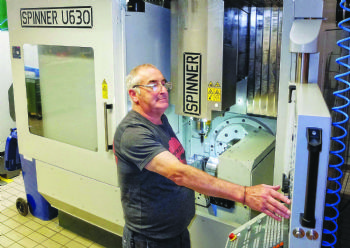
Traditionally a user of three-axis vertical machining centres, Singer Instruments — based in Watchet, on the north coast of Somerset — installed its first five-axis CNC machine at the start of this year, to streamline the manufacture of aluminium components.
The German-built Spinner U5-630 — a 40-taper machine with a nominal 0.5m-cube capacity — was supplied by the manufacturer’s Kenilworth-based sole UK agent, Whitehouse Machine Tools (
www.wmtcnc.com).
It is equipped with high-pressure through-spindle coolant and a separate clean tank, as well as Blum spindle-mounted workpiece probing and a tool-setting probe.
Cycle time savings have been dramatic, as there has been a considerable reduction in the number of set-ups needed across a raft of different parts. These savings are a result of using the two additional rotary CNC axes (provided by the swivelling trunnion and rotary table) to reposition components automatically.
In one case, a table for Singer Instruments’ ROTOR automated screening instrument (used in the biological sciences sector) is produced in three set-ups, whereas it previously required nine separate prismatic machining operations on a three-axis VMC.
More typically, components that previously needed six operations are now produced in two; and in the example of a part for a genomic screening instrument, the machining time was cut from 45min to just eight.
In addition to higher productivity, other benefits of fewer set-ups include less handling, lower fixturing costs, and enhanced accuracy through fewer clampings. Furthermore, with average batch sizes in the range 10-20, a lot of work in progress is eliminated.
Maintaining tolerances
Singer Instruments’ investment in five-axis capacity was instigated by Steve Maconnachie, a CNC machinist who previously ran a Midlands-based sub-contract machining business with his brother and has been using five-axis technology for many years. He was familiar with all the leading makes of machine, many of which were reviewed before the decision was taken to buy the Spinner.
He said: “Some of our components have a tolerance of just ±5µm, so we maintain the temperature of our production area to within a couple of degrees Celsius; and while many of the five-axis machines we considered could hold this tolerance, the Spinner easily holds it yet was little more than half the cost of one of the other production centres we shortlisted.”

He also highlighted the service provided by Whitehouse, which included removing the 54-pocket tool magazine and Z-axis motor so that the machine would pass through the door of Singer Instruments’ building. Moreover, the U5-630 has a compact footprint (about 2.7 x 2.4m), which is beneficial, as space at the factory is somewhat limited.
Every component used in Singer Instruments’ products is designed in-house, using SolidWorks.
Based on the models created, programming is carried out using FeatureCAM running on a PC; the data is subsequently transferred to the Spinner’s Heidenhain TNC 620 control via the latter’s TNCremo software.
All the other machining centres on the shopfloor also have Heidenhain controls and are similarly linked to the CAM system.
Currently, all five-axis cycles involve 3+2-axis cutting strategies, as components have historically been designed for production on three-axis machining centres.
However the Spinner machine is capable of fully interpolative five-axis machining, so parts being designed for new electronic workstations and laboratory automation equipment (used world-wide for research into genetics, neuroscience, cancer, biofuel engineering and microbiology) will be designed with the Spinner machine’s enhanced capabilities in mind.